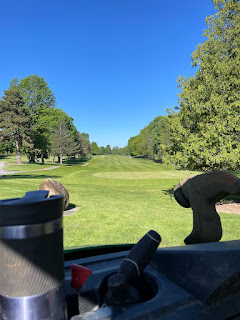Drying out and moving on
Average rainfall for May is between 3 and 4 inches. Syracuse logged over 5 inches in May alone this year and it always seemed to fall on cold weekends. The course remained playable, if not lush, but golf cart usage was limited. Finishing up projects before Memorial day is something we care about and push hard for. Unfortunately work stoppage due to weather caused a delay in completing projects.
Most affected among spring work was paving. Upstate Paving was in early to prep the worst paths on the course around tees and greens in hopes to be ready to pave when asphalt plants opened in early May. Plans were to tackle the paths close to access roads so their equipment didn't rut the course. As the rains conitnued, we watched our window for spring paving disappear.
The biggest continuous path will be the sections from 7 through to 9 tee. These areas were orignally going to be paved later in the summer when ground firmed up enough to support heavy trucks. As it became clearer the weather wasn't going to cooperate we decided to get the project ready to be completed in one visit from Upstate.
The cartpath on the right will be retired and moved to the left as planned. Trees were removed last winter prior to this work to make way for the new cart route. The access to 8 green will now be from the left and rear of the green. The path was stopped before it crossed shallow irrigation lines in that vicinity. Access to 9 tee will be from the left of the tee where the incline is gentle.
The old path will be grassed over and a privacy berm will be added at 9 tee beginning just west of Frank Gay Rd. This will shield the tee from what's going on along howlett Hill road similar to other holes on the frontage roads. The upper tee deck will be expanded and total usable teeing space will remain unchanged. This project kicks off more work to come this winter dressing up and landscaping from the corner of Munro and Howlett Hill to the clubhouse entry road.
With so much construction happening around Syracuse, and with the sloppy weather, the soonest date we could book was the week after Men's MG. Paving will take 2 days and the paths should be open for use soon after. Look for more updates in July as we get closer to finishing this improvement to the course.
Moving on up
 |
| Getting started on 5 tee |
 |
| Directing traffic |
 |
| Final form |
Ponderous
Discussion continues on the fate of the pond on 12. Both solutions share the downside of being expensive to implement. What was a well-intentioned pond 100 years ago has become unsustainable due to land development, agricultural land use, and a better awareness about managing water within a Karst topography. The green committee will continue to weigh both options (deep pond or creek) and hope to have a recommendation for the board by the end of the season. And for those that ask, because it's a natural question; If it were as easy as putting a pond fountain in, we'd have done it already.. |
| Filamentous Algae bloom due to shallow depth allowing light to penetrate to the pond floor teamed with elevated nutrient levels from farming runoff |
 |
| Squirrels beware! |









.jpg)


































